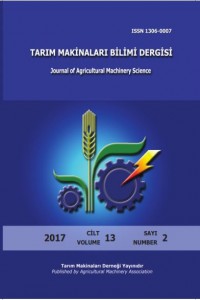Abstract
There are many factors that influence
the health and productivity of the animals in livestock production fields,
including temperature, humidity, carbon dioxide (CO2), ammonia (NH3),
hydrogen sulfide (H2S), physical activity and particulate matter.
High NH3 concentrations reduce feed consumption and cause daily
weight gain. In addition, at high concentrations, H2S causes
respiratory problems and CO2, displace oxygen, which can cause
suffocation or asphyxiation. Good air quality in livestock facilities can have
an impact on the health and well-being of animals and humans. Air quality
assessment is basically depend on strictly given limits without taking into
account specific local conditions between harmful gases and other
meteorological factors. The stated limitations may be eliminated using
controlling systems based on neural networks and fuzzy logic. This paper
describes a fuzzy logic based ventilation algorithm, which can calculate
different fan speeds under pre-defined boundary conditions, for removing
harmful gases from the production environment. In the paper, a novel model has
been developed based on a Mamedani’s fuzzy logic method. The model has been
built on MATLAB software. As the result, optimum fan speeds under pre-defined
boundary conditions have been presented.
References
- Burmeister, A., M., 1986. Jurkschat, M. Nichelmann. Influence of stocking density on the heat balance in the domestic fowl (Gallus domesticus). Journal of Thermal Biology, vol. 11, pp. 117-120.
- Charles, D. R., 1984. A model of egg production. British Poultry Science, vol. 25, pp. 309-321.
- CIGR, 1984. Climatisation of animal houses. Report of working group, Scottish Farm Building Investigation Unit, Craibstone, Aberdeen, Scotland.
- Donham, K. J., D. Cumro, S. J. Reynolds and J. A. Merchant, 2000. Dose-response relationships between occupational aerosol exposures and cross-shift declines of lung function in poultry workers: recommendations for exposure limits, J. Occup. Environ. Med. Vol. 42, pp. 260-269.
- Gay, S. W., 2009. Ammonia Emissions and Animal Agriculture. Virginia Cooperative Extension. Puplication 442-110. Biological Systems Engineering College of Agriculture and Life Sciences, Virginia Polytechnic Institute and State University, Virginia State, Petersburg, USA.
- Henken, A. M., H. A. Brandsma, W. V. D. and Hel, M. W. A., 1991. Verstegen, Heat balance characteristics of limit-fed growing pigs of several breeds kept in groups at and below thermal neutrality. Journal of Animal Science vol. 69, pp. 2434-2442.
- Issley, S. S., E. Lang, 2015. Subject: Ammonia toxicity. https://emedicine.medscape.com/article/820298-overview (Online: June 2017)
- Macleod, M. G., 1984. Factors influencing the agreement between thermal physiology measurements and field performance in poultry. Archive of Experimental Veterinary Medicine, vol. 38, pp. 399-410.
- Mamdani, E. H., S. Assilion, 1974. An Experiment in Linguistic Synthesis with a Fuzzy Logic Controller", Intl J. Man-Machine Stud. Vol.7, pp. 1-13.
- Mendel, J., 1995. Fuzzy logic systems for engineering: a tutorial", Proceedings of the IEEE, vol. 83(3), pp. 345-377. Merchant, J. A., J. Kline, K. J. Donham, D. S. Bundy, and C. J. Hodne, 2003. Human health effects. In Iowa concentrated animal feeding operation air quality study. University of Iowa, Ames, Iowa. pp. 121-145.
- Wang, H. O., K. Tanaka, and M. F. Griffin, 1996. An approach to fuzzy control of nonlinear systems: Stability and design issues, IEEE Trans. Fuzzy Syst., vol. 4, pp. 14-23.
- Webster, A. J. F., 1981. Optimal housing criteria for ruminants. In: Environmental Aspects of Housing for Animal Production, Clark J A (ed.), London: Butterworths, pp. 217-232.
Details
| Journal Section | Articles |
|---|---|
| Authors | |
| Publication Date | December 26, 2017 |
| Published in Issue | Year 2017 Volume: 13 Issue: 2 |
Journal of Agricultural Machinery Science is a refereed scientific journal published by the Agricultural Machinery Association as 3 issues a year.

